Clinical and Bacteriological Profiles of Neonatal Sepsis in a Tertiary Hospital, South-Western Nigeria
Abstract
Introduction
Methods
Ethical consideration
Study location and study design
Study population
Sample collection
Cultures
Blood culture
Interpretation of culture
- Maternal predisposing factors like fever or foul-smelling liquor or prolonged rupture of membranes (>24 h) or gastric polymorphs (>5 per high power field).
- Presence of at least two of these four parameters:
- total leukocyte count (<5000/cmm),
- band to total polymorphonuclear cells ratio of >0.2,
- absolute neutrophil count <1800/cmm,
- C-reactive protein (CRP) >1mg/dL and ESR >10 mm-first hour.
- Radiological evidence of pneumonia.
- Isolation of pathogens from blood or CSF or urine or abscess(es).
Serum biomarker
Bacterial identification
Antibiotic susceptibility test
Phenotypic resistance testing of extended-spectrum β-lactamase (ESBL) production, AmpC beta-lactamase and carbapenemase production
Determination of genetic determinants of phenotypic resistance
Primer sequences for selected ESBL genes (blaTEM, blaSHV, blaCTX-M, blaKPC, blaNDM, blaVIM, blaOXA, mecA) and amplification reactions
Data and statistical analysis
Results
Incidence rates
Clinical characteristics of neonates
Signs and symptoms of sepsis associated with culture-positive neonatal sepsis
Factors associated with neonatal deaths
Bacterial profile of neonatal sepsis
Pattern of antibiotic resistance in isolated bacteria in neonatal sepsis
Prevalence and types of resistance genes among the bacterial isolates in neonatal sepsis
Discussion
Conclusions
Supplementary material
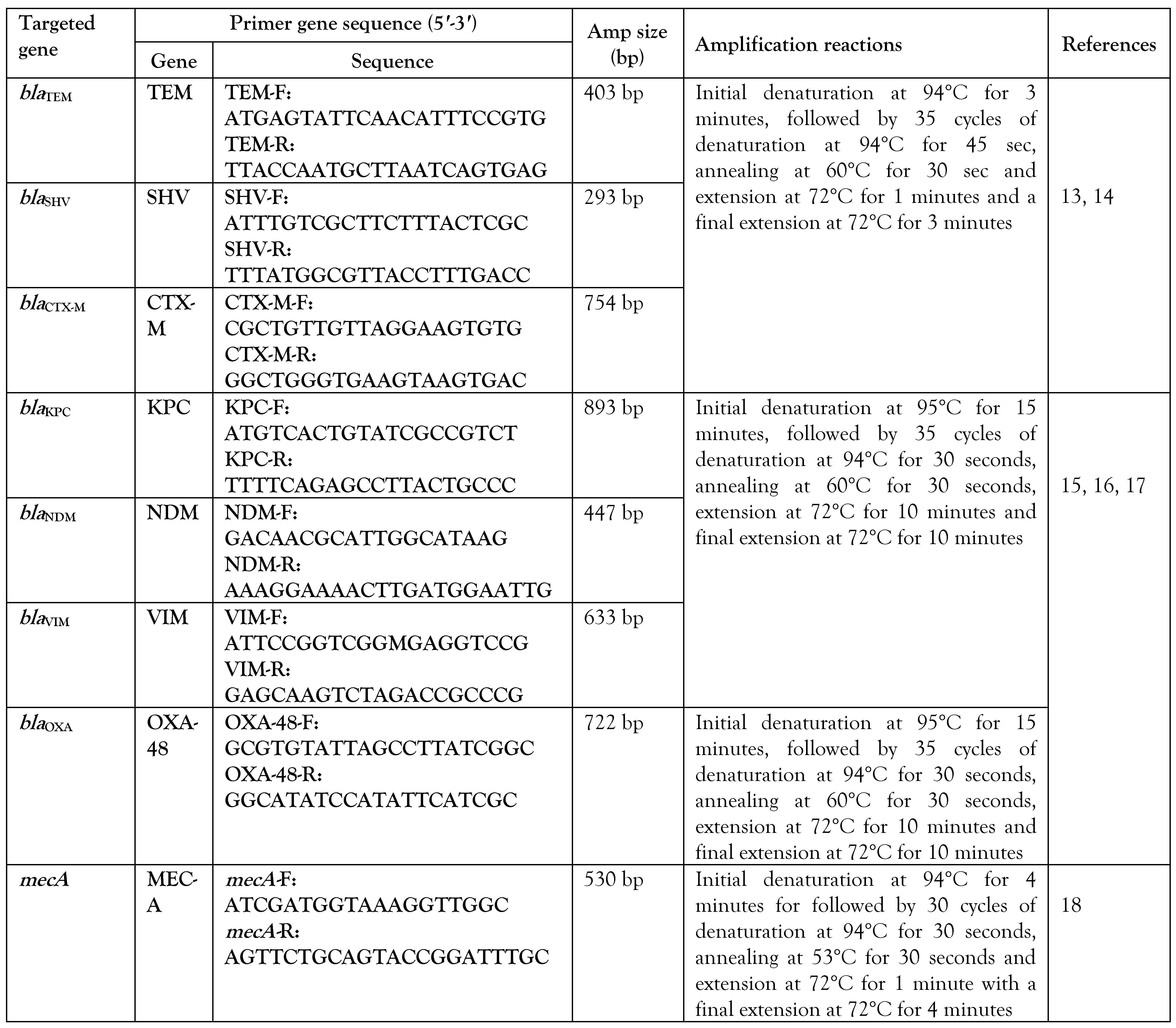 |
Author Contributions
Funding
Institutional Review Board Statement
Data Availability Statement
Acknowledgments
Conflicts of interest
References
- Vergnano, S.; Sharland, M.; Kazembe, P.; Mwansambo, C.; Heath, P.T. Neonatal sepsis: An international perspective. Arch Dis Child Fetal Neonatal Ed. 2005, 90, F220–F224. [Google Scholar] [CrossRef]
- United Nations Inter-agency Group for Child Mortality Estimation (UN IGME). Levels & Trends in Child Mortality Estimation Child Mortality. United Nations Children's Fund. 2020.
- Okeke, I.N.; Lamikanra, A.; Edelman, R. Socioeconomic and behavioral factors leading to acquired bacterial resistance to antibiotics in developing countries. Emerg Infect Dis. 1999, 5, 18–27. [Google Scholar] [CrossRef]
- Giannoni, E.; Schlapbach, L.J. Editorial: Sepsis in neonates and children. Front Pediatr. 2020, 8, 621663. [Google Scholar] [CrossRef] [PubMed]
- Obiero, C.W.; Seale, A.C.; Berkley, J.A. Empiric treatment of neonatal sepsis in developing countries. Pediatr Infect Dis J. 2015, 34, 659–661. [Google Scholar] [CrossRef] [PubMed]
- Fuchs, A.; Bielicki, J.; Mathur, S.; Sharland, M.; Van Den Anker, J.N. Reviewing the WHO guidelines for antibiotic use for sepsis in neonates and children. Paediatr Int Child Health. 2018, 38, S3–S15. [Google Scholar] [CrossRef] [PubMed]
- European Medicines Agency. Report on the Expert Meeting on Neonatal and Paediatric Sepsis. 2010. 2010.
- Leber, A.L. Clinical Microbiology Procedures Handbook, 4th ed.; ASM Press: Washington, DC, 2017. [Google Scholar] [CrossRef]
- Delhi, N. National Neonatal-Perinatal Database. NNPD Nodal Cent Dep Pediatr WHO Collab Cent Newborn Train Res All India Inst Med Sci. 2005, 1–70. 2005; 1–70. [Google Scholar]
- Stocker, M.; van Herk, W.; El Helou, S.; et al. Procalcitonin-guided decision making for duration of antibiotic therapy in neonates with suspected early-onset sepsis: A multicentre, randomised controlled trial (NeoPIns). Lancet 2017, 390, 871–881. [Google Scholar] [CrossRef]
- Clinical and Laboratory Standards Institutes (CLSI). Clinical and Laboratory Standards for Antimicrobial Susceptibility Testing, 29th ed.; Report No.: 34 CLSI supplement M100; CLSI: Wayne, PA, 2019. [Google Scholar]
- Giske, C.G.; Martinez-Martinez, L.; Cantón Spain, R.; et al. EUCAST guidelines for detection of resistance mechanisms and specific resistances of clinical and/or epidemiological importance. EUCAST; 2017. pp. 1–43.
- Ramachandran, A.; Shanthi, M.; Sekar, U. Detection of blaCTX-M extended spectrum betalactamase producing Salmonella enterica serotype Typhi in a tertiary care centre. J Clin Diagnostic Res. 2017, 11, DC21–DC24. [Google Scholar] [CrossRef]
- Bali, E.B.; Açık, L.; Sultan, N. Phenotypic and molecular characterization of SHV, produced by Escherichia coli, Acinetobacter baumannii and Klebsiella isolates in a Turkish hospital. African J Microbiol Res. 2010, 4, 650–654. [Google Scholar]
- Pasanen, T.; Koskela, S.; Mero, S.; et al. Rapid molecular characterization of Acinetobacter baumannii clones with rep-PCR and evaluation of carbapenemase genes by new multiplex PCR in Hospital District of Helsinki and Uusimaa. PLoS ONE. 2014, 9, e85854. [Google Scholar] [CrossRef]
- Zhao, S.Y.; Jiang, D.Y.; Xu, P.C.; et al. An investigation of drug-resistant Acinetobacter baumannii infections in a comprehensive hospital of East China. Ann Clin Microbiol Antimicrob. 2015, 14, 7. [Google Scholar] [CrossRef]
- Balkan, I.I.; Aygün, G.; Aydin, S.; et al. Blood stream infections due to OXA-48-like carbapenemase-producing Enterobacteriaceae: Treatment and survival. Int J Infect Dis. 2014, 26, 51–56. [Google Scholar] [CrossRef] [PubMed]
- Sajith Khan, S.; Shetty, P.J.; Lakshmi Sarayu, Y.; Chidambaram, A.; Ranganathan, R. Detection of mecA genes of methicillin-resistant Staphylococcus aureus by polymerase chain reaction. Int J Health Rehabil Sci. 2012, 1, 64–68. [Google Scholar]
- Hibberd, P.L.; Hansen, N.I.; Wang, M.E.; et al. Trends in the incidence of possible severe bacterial infection and case fatality rates in rural communities in Sub-Saharan Africa, South Asia and Latin America, 2010-2013: A multicenter prospective cohort study. Reprod Health. 2016, 13, 65. [Google Scholar] [CrossRef] [PubMed]
- Adejuyigbe, E.A.; Adeodu, O.O.; Ako-Nai, K.A.; Taiwo, O.; Owa, J.A. Septicaemia in high risk neonates at a teaching hospital in Ile-Ife, Nigeria. East Afr Med J. 2001, 78, 540–543. [Google Scholar] [CrossRef]
- Opiyo, N.; English, M. What clinical signs best identify severe illness in young infants aged 0-59 days in developing countries? A systematic review. Arch Dis Child. 2011, 96, 1052–1059. [Google Scholar] [CrossRef]
- Kenzaka, T.; Okayama, M.; Kuroki, S.; et al. Use of a semiquantitative procalcitonin kit for evaluating severity and predicting mortality in patients with sepsis. Int J Gen Med. 2012, 5, 483–488. [Google Scholar] [CrossRef]
- Fernandes, L.; Arora, A.S.; Mesquita, A.M. Role of semi-quantitative serum procalcitonin in assessing prognosis of community acquired bacterial pneumonia compared to PORT PSI, CURB-65 and CRB-65. J Clin Diagnostic Res. 2015, 9, OC01–OC04. [Google Scholar] [CrossRef]
- Medugu, N.; Iregbu, K.; Tam, P.I.; Obaro, S. Aetiology of neonatal sepsis in Nigeria, and relevance of Group b streptococcus: A systematic review. PLoS ONE. 2018, 13, e0200350. [Google Scholar] [CrossRef]
- Chaurasia, S.; Sivanandan, S.; Agarwal, R.; Ellis, S.; Sharland, M.; Sankar, M.J. Neonatal sepsis in South Asia: Huge burden and spiralling antimicrobial resistance. BMJ. 2019, 364, k5314. [Google Scholar] [CrossRef]
- Waters, D.; Jawad, I.; Ahmad, A.; et al. Aetiology of community-acquired neonatal sepsis in low-and middle-income countries. J Glob Health. 2011, 1, 154–170. [Google Scholar]
- Lokangaka, A.; Bauserman, M.; Coppieters, Y.; et al. Simplified antibiotic regimens for treating neonates and young infants with severe infections in the Democratic Republic of Congo: A comparative efficacy trial. Matern Heal Neonatol Perinatol. 2018, 4, 8. [Google Scholar] [CrossRef]
- African Neonatal Sepsis Trial (AFRINEST) group; Tshefu, A.; Lokangaka, A.; et al. Oral amoxicillin compared with injectable procaine benzylpenicillin plus gentamicin for treatment of neonates and young infants with fast breathing when referral is not possible: A randomised, open-label, equivalence trial. Lancet 2015, 385, 1758–1766. [Google Scholar] [CrossRef]
- Sands, K.; Carvalho, M.J.; Portal, E.; et al. Characterization of antimicrobial-resistant Gram-negative bacteria that cause neonatal sepsis in seven low-and middle-income countries. Nat Microbiol. 2021, 6, 512–523. [Google Scholar] [CrossRef]
- Jiang, N.; Li, J.; Feßler, A.T.; Wang, Y.; Schwarz, S.; Wu, C. Novel pseudo-staphylococcal cassette chromosome mec element (φSCCmecT55) in MRSA ST9. J Antimicrob Chemother. 2019, 74, 819–820. [Google Scholar] [CrossRef]
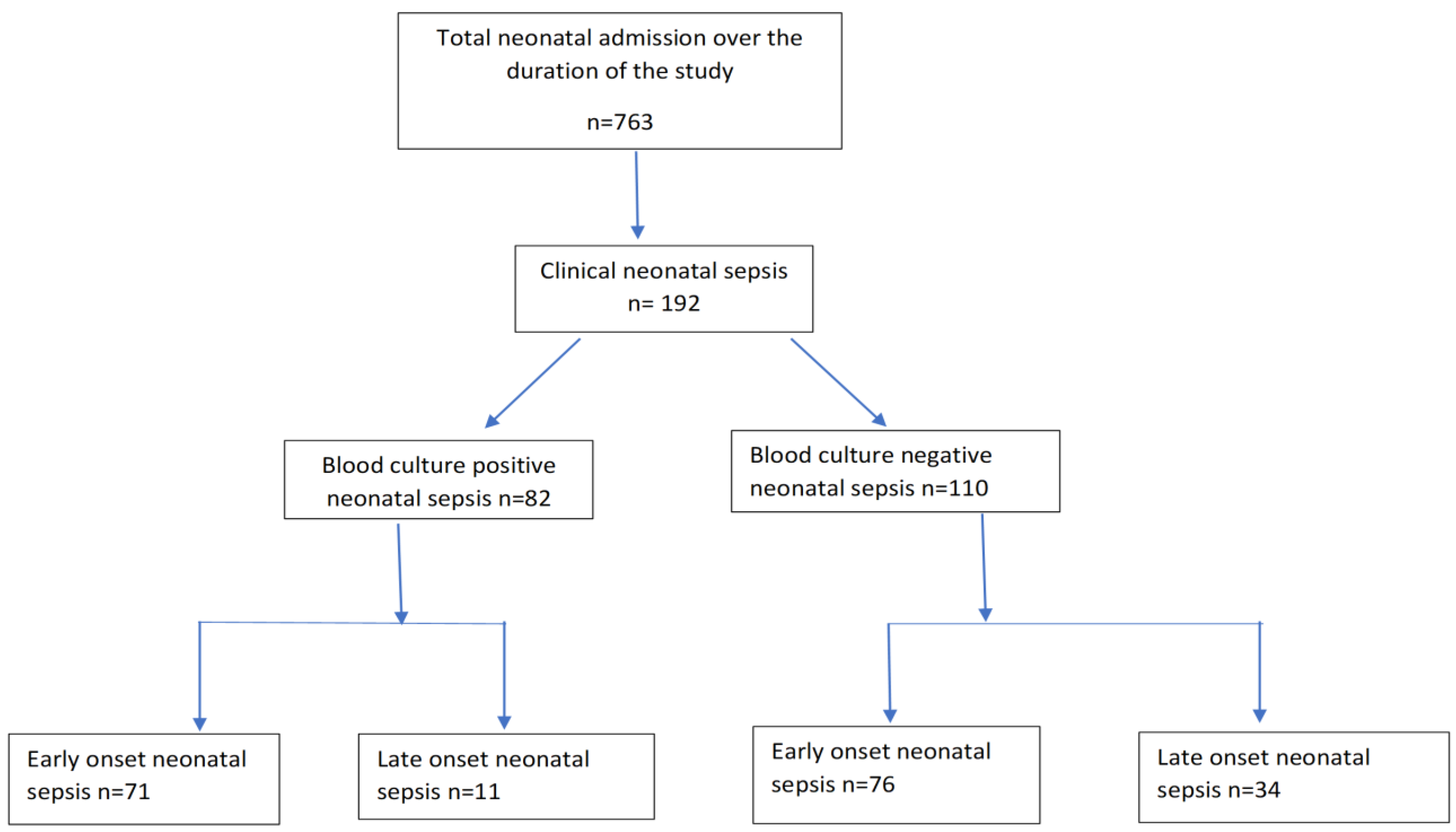
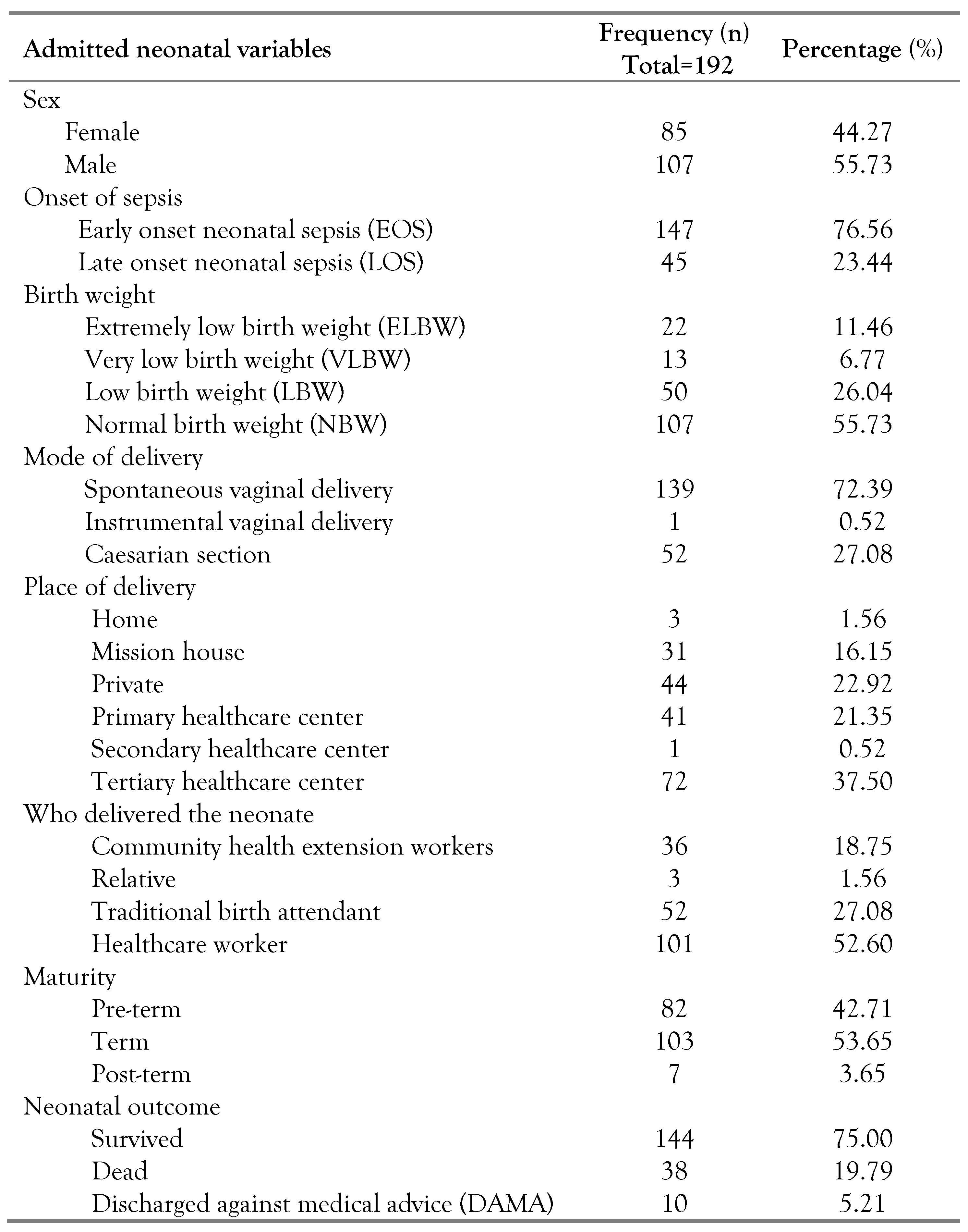 |
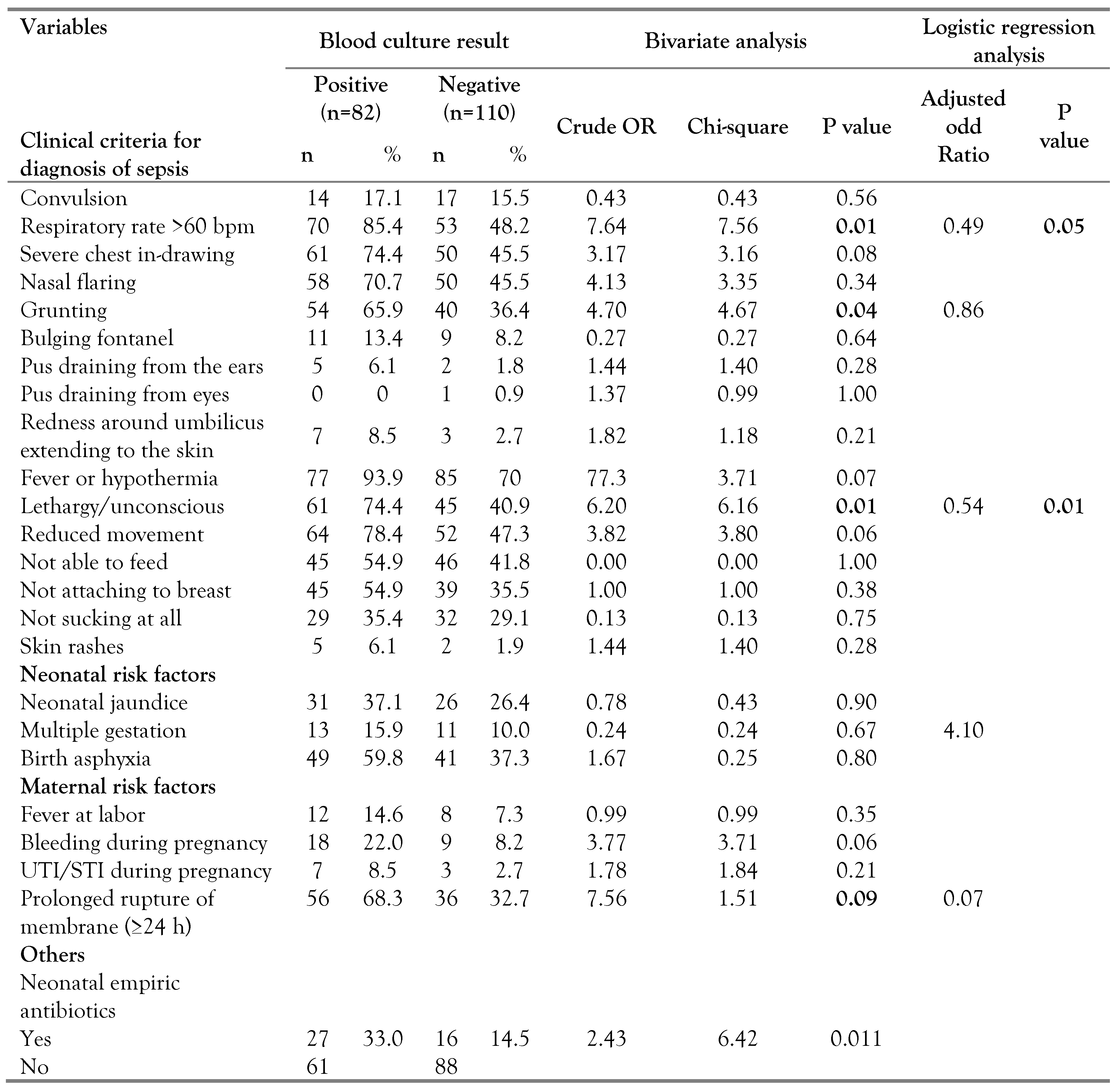 |
 |
 |
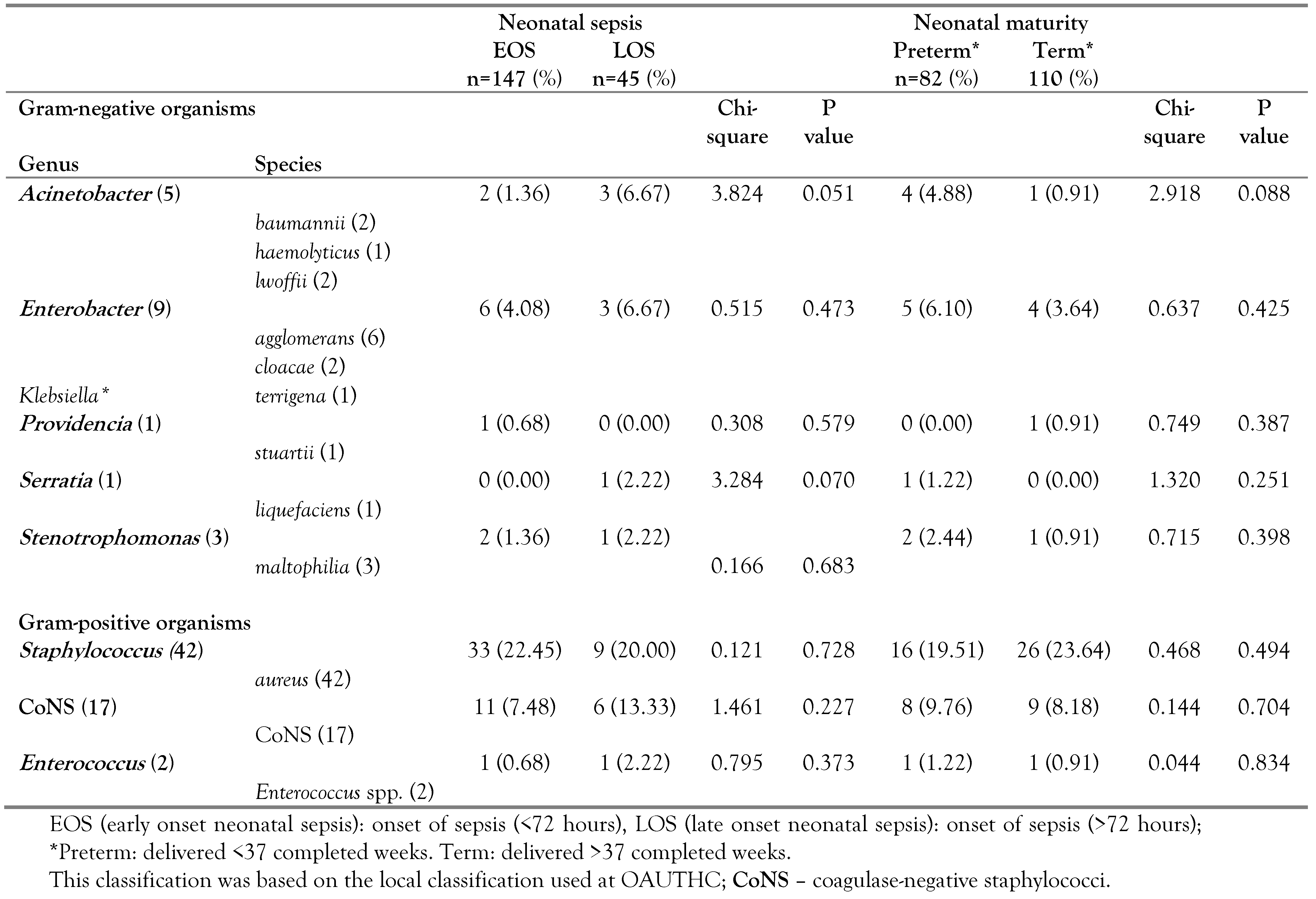 |
© GERMS 2023.
Share and Cite
Obadare, T.O.; Adejuyigbe, E.A.; Adeyemo, A.T.; Amupitan, A.A.; Ugowe, O.J.; Anyabolu, C.H.; Aboderin, A.O. Clinical and Bacteriological Profiles of Neonatal Sepsis in a Tertiary Hospital, South-Western Nigeria. GERMS 2023, 13, 137-150. https://doi.org/10.18683/germs.2023.1377
Obadare TO, Adejuyigbe EA, Adeyemo AT, Amupitan AA, Ugowe OJ, Anyabolu CH, Aboderin AO. Clinical and Bacteriological Profiles of Neonatal Sepsis in a Tertiary Hospital, South-Western Nigeria. GERMS. 2023; 13(2):137-150. https://doi.org/10.18683/germs.2023.1377
Chicago/Turabian StyleObadare, Temitope O., Ebunoluwa A. Adejuyigbe, Adeyemi T. Adeyemo, Adewale A. Amupitan, Osagie J. Ugowe, Chinemere H. Anyabolu, and Aaron O. Aboderin. 2023. "Clinical and Bacteriological Profiles of Neonatal Sepsis in a Tertiary Hospital, South-Western Nigeria" GERMS 13, no. 2: 137-150. https://doi.org/10.18683/germs.2023.1377
APA StyleObadare, T. O., Adejuyigbe, E. A., Adeyemo, A. T., Amupitan, A. A., Ugowe, O. J., Anyabolu, C. H., & Aboderin, A. O. (2023). Clinical and Bacteriological Profiles of Neonatal Sepsis in a Tertiary Hospital, South-Western Nigeria. GERMS, 13(2), 137-150. https://doi.org/10.18683/germs.2023.1377




